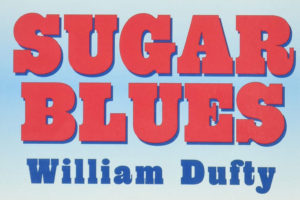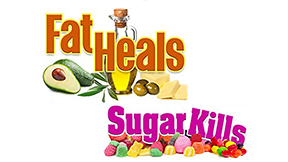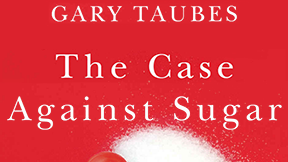 by William Dufty:
by William Dufty:
Dufty takes us back to the beginning of time, Paradise Lost and the Garden of Eden. He references Biblical references to people living a very long time. He discusses ancient Chinese acupuncture meridians, which are called beauty marks in the West, dark spots that appear at the time of birth or later.
When these charts are compiled thousands of year ago, “natural death” was going to sleep without waking up—was the normal way to die….refined sugar [sucrose] did not form a part of the human diet.
He relays to us the diet of these early people which consisted of a variety of nuts including almonds, chestnuts, walnuts, and pistachios. For fruits and vegetables they had apples, fig, grapes, mulberries, olives, melons, carob, mint, onion, anise, cucumbers, lentils, and mustard. For grains they had barley, millet, rye, and wheat. They had milk and honey and a multitude of natural goodies. Most all of these had natural sugars.
Dufty explains that none of the ancient books, the Bible, the Code of Mann, the I Ching, the Yellow Emperors Classic of Internal Medicine, the New Testament and the Koran, make any reference to sugar. He references “sweet cane” that may have come from India and Polynesian myths and legends that made much of this sweet cane. It was native to tropical climes, and efforts to cultivate it elsewhere failed.
The sweet cane “was cultivated with great labor by husbandman who bruise it when ripe in mortars, set the juice in a vessel until concreted in form like snow or white salt.”
The Greeks described it as a “kind of honey” growing in canes of reeds. Early Roman and Greek accounts compared it to basic staples of the time, “Indian salt” or “honey without bees; and they imported it at an enormous cost. The Persians were credited with the research and development of a process for refining the juice of the cane into a solid form that would last without fermenting. It was feasible to transport the product. He sets the time around 600 A.D. Dufty continues with this interesting quote:
The Persian empire rose and fell, as empires always do. When the armies of Islam overran them, one of the trophies of victory was the secret for processing sweet cane into medicine.
Dufty recounts the victories of the Arab armies and the spread of the Arab empire. He continues:
It is tempting to wonder from eyewitness reports that turn up later, what role sugar played in the decline of the Arab empire. Sugar is not mentioned [in the Koran], but the heirs of the Prophet [Mohammad] are probably the first conquerors in history to have produced enough sugar to furnish both troops and courts with candy and sugared drinks. An early European observer credits the widespread use of sugar by desert fighters as their reason for their loss of cutting edge.
The author quotes Leonhard Rauwolf, a German botanist:
The Turks and Moors cut off one piece [of sugar] after another and so chew and eat them openly everywhere in the street without shame…in this way [they] accustom themselves to gluttony and are no longer the intrepid fighters they had formerly been.
Dufty comments, “This may be the first recorded warning from the scientific community on the subject of sugar abuse and its observed consequences.” He draws a parallel with the Christian Crusaders. They, too, acquired a taste for the “sauce of the Saracens”. He quotes Pope Clement V advocating that the Christians, too, get in the sugar business.
…If the Christians could seize those lands [the Sultans] great injury would be inflicted on the Sultan and at the same time Christendom would be wholly supplied from Cyprus. Sugar is also grown in the Morea, Malta, and Sicily, and it would grow in other Christian lands if cultivated there. As regards Christendom, no harm would follow.
Dufty explains that Christians took a big bite of the “forbidden fruit”. What followed was seven centuries in which the seven deadly sins flourished across the seven seas, leaving a trail of slavery, genocide, and organized crime.
My comments: Yes, the forbidden fruit: I had a paper route, and in those days the paperboy collected for the monthly subscription. I had change jingling in my pocket, and there were little mom and pop markets all around me. I could easily sneak a soda pop or a Snickers bar. It was easy to get hooked on the sweet stuff.
I recall my son’s morbidly obese Cub Scout leaders acting as drug pushers in tantalizing their charges with CAKE!! after the evening’s activities. I remember fighting with my brother over splitting a leftover piece of cake, pie, or candy as to who got the biggest piece. Funny thing, we never fought over who got how much of the leftover vegetables! So yeah, it’s easy to understand how these people of hundreds of years ago went berserk over sugar. I was no different.
Continuing: Dufty quotes the British historian, Noel Deerr: “It will be no exaggeration to put the tale and toll of the slave trade at 20 million Africans, of which two thirds are to be charges against sugar.” He then spends the next couple of pages describing the growth of the Portuguese and Spanish slave trade and sugar cultivation. Then the Dutch got into the act by 1500.
No other product has so profoundly influenced the political history of the Western world as has sugar. . .The Portuguese and Spanish empires rose swiftly in opulence and power. As the Arabs before them had crumbled, so they too fell rapidly into a decline. To what extent that decline was biological—occasioned by sugar bingeing at the royal level—we can only guess. However, the British empire stood by waiting to pick up the pieces.
He tells us that Queen Elizabeth initially called the slave trade, “detestable”, but she soon capitulated. The Queen sanctioned the Company of Royal Adventurers of England, which gave them a state monopoly of the West African slave trade. In the West Indies the Spaniards had exterminated the natives and brought African slaves to tend their fields of cane.
Comment: What is a 20th century parallel to the 15th and 16th century European sugar craze? I would think that one parallel is the oil rush. Just like the machinations of the governments back then, I think of the 1953 U.S. CIA sponsored overthrow of the democratically elected Iranian Prime Minister Mohammad Mosaddegh. He nationalized the Iranian oil industry, and the Western powers [Standard Oil and BP] didn’t like that. Weren’t Gulf Wars I and II primarily about oil? Sugar then, oil now.
Continuing: The sugar trade in the West Indies grew in another way. Fermented cane juice was turned into rum. The first rum runner imported their precious tonic to New England where a “pennies worth” of rum was traded with the Indians for furs. That latter were sold in Europe for a fortune. On the return voyage back to the New World, the ships of the Queen’s Company of Royal Adventurers visited the West African coast to pick up more slaves, who in turn would tend the sugar cane fields to produce more sugar, molasses and rum.
It was rum for the American Indians, molasses for the American colonists, and sugar and furs for Europe. It was quite a neat deal until the land in Barbados and other British islands was worn out and exhausted.
Britain’s Navigation Acts of 1660 required that the trade of all British colonies had to be with England, Ireland, and British possessions. Mother England wanted to protect her revenues and maintain the priceless shipping monopoly. Dufty explains that by the 1860’s sugar became a synonym for “money” in the English language.
He explains that the Molasses Act of 1733 did as much or more to precipitate the American War of Independence as did the Boston Tea Party. The act levied a heavy tax on sugar or molasses coming from anywhere other than the British sugar islands in the Caribbean. The ship owners of New England cut themselves in. They delivered rum to West Africa in exchange for more slaves, who were then sold to the British plantation owners. Then they shipped molasses back to the colonies which was to be distilled into rum. Dufty explains that the per capita consumption of rum in the colonies was an annual four gallons per person.
Dufty quotes the French philosopher Claude Adrien Helvetius: “No cask of sugar arrives in Europe to which blood is not sticking. In view of the misery of these slaves anyone with feelings should renounce these wares and refuse the enjoyment of what is only to be bought with tears and death of countless unhappy creatures.”
Helvetius was forced to recant [in part to save his skin], as the French were cutting themselves in on the sugar trade. The Sorbonne [University of Paris] condemned him and his books were burned. Nevertheless, the genie was out of the bottle.
The stigma of slavery was on sugar everywhere, but most particularly in Britain. Everywhere sugar had become a source of public wealth and national importance. Through taxes and tariffs on sugar, government had remained a partner in organized crime. Fabulous fortunes were being amassed by plantation owners, planters, traders and shippers; and the sole concern of European royalty was how they would take their cut.
My comments: Are things much different today? President Nixon was paranoid about the 1972 election, and one of his concerns was rising food prices. He teamed up with the then Secretary of Agriculture, Earl Butz, to start massive government subsidies for the growing of corn in an effort to keep food prices low. Japanese scientists figured out in the early 1970’s how to make high fructose corn syrup [HFCS] from that cheap corn. Therefore, we now have the price HFCS being kept artificially low through government subsidies and the price of imported sugar kept artificially higher because of tariffs. Sound familiar?
Meanwhile, large multi-national corporations are making a fortune by selling, cheap, low quality, disease-facilitating food [if you can call it food] and beverages to the unsuspecting public all laced with HFCS. And on the farm we now have herbicide-resistant genetically modified organisms [GMO’s] being doused with herbicides. The lobbyists in the corn producing states push to keep the cash cow flowing. And the politicians are bribed [through campaign contributions] to continue to vote the status quo, and the tax-payers are pick-pocketed to finance the entire scheme.
Future generations have to be properly trained to keep the show rolling along. Schools have gotten in on the act by allowing soda-pop vending machines on campus, although due to protests, some have since been removed. At least one elementary school in Lewiston, ID has a Pepsi logo on its outdoor info sign. Our local skateboard park is called “Mountain Dew Skateboard Park”. The objective is to burn the logos of these sugary drinks into the minds of new consumers.
The craze for sugar certainly continues. What about the slaves? We don’t have them anymore, or do we? If we do, who are they?
Continuing: Dufty explains the British Empire was totally hooked on the issue of sugar. Gluttony had produced necessity. Sugar and slavery were indivisible. Therefore, they were defended together. When sugar was originally introduced in England, a pound cost an entire year’s salary for the average working man. As the sugar trade increased, the price fell precipitously. By 1700 the British Isles were accounting for 20 million pounds of sugar per year. By 1800 it was 160 million pounds per year. The consumption had gone up eight-fold. A hundred years later the British were spending as much on sugar as they were on bread. The consumption had increased to 73 pounds per person per year.
The French didn’t sit idly by. By 1700 refined sugar was France’s most important export. The British struck back with naval blockades, cutting off their source of sugar cane. A German scientist, Franz Carl Achard, was experimenting with a “type of parsnip” from Italy, originally believed to be from Babylonia. Under pressure from the blockade, French scientists found a way to process the beet into a new kind of sugar “loaf”. Napoleon ordered beets to be planted everywhere in France. [Sound familiar?]
After Napoleon had beaten Britain’s naval blockade, the Quakers in Britain took up the cultivation of sugar beets as an anti-slavery gesture. The status quo producers of sugar from sugar cane saw that as a serious threat and demanded that the “Quakers be uprooted”. Most of their beets were fed to cows, and it wasn’t until a shipping shortage spawned by WW-I that Britain resumed the growing of sugar beets. [
The French abolished the slave trade in 1807, and the British did so 26 years later. The British indemnified slaveholders in Barbados and Jamaica $75 to $399 a head. Before then, there were plenty of slave revolts threatening those that ran the plantations. After the abolition of slavery, East Indian immigrants were imported to man what was left of the powerful sugar business.
Up until this time, refined sugar was a raw, light brown-like sugar. New American inventions were about to change that forever. James Watt perfected the steam engine, Figuier developed a method for making charcoal out of animal bones, and Howard produced the vacuum pan. Now the Americans could produce white, crystalline sugar. Cuba became the new, back door colony for the U.S. Import duties of $0.02 per pound provided for 20% of federal revenues.
Americans soon outdistanced the British and virtually every other nation in sugar bingeing. The U.S. had consumed one-fifth of the world’s production of sugar every year but one since the Civil War. By 1893 America was consuming more sugar than the whole world had produced in 1865. By 1920…that figure for sugar production had doubled….It is doubtful there has ever been more of a challenge to the human body in the entire history of man.
Dufty draws several parallels of opium trade and production of the “mark of cane”. They both began as medicines and ended up being used for habit forming sensory pleasures. The opium traffic, as with sugar, seems to have originated in Persia. Fortunes were made in their trade. Opium was refined into morphine which was injected into those with sugar-induced diabetes, as the hypodermic needle had been invented by then. Taxes were collected from both of them. Many Union soldiers came home that were completely addicted to morphine. Morphine was further refined into heroin, and the latter was also used to treat sugar diabetes.
Dufty quotes Dr. Robert Boesler’s [a dentist] 1912 comments:
Modern manufacturing of sugar has brought about entirely new diseases. The sugar of commerce is nothing else but concentrated crystalized acid. If, in former times sugar was so costly that only the wealthy could afford to use it, it was, from the national economic standpoint, of no consequence. Today…because of its low cost, sugar has caused a degeneration of the people….The loss of energy through the consumption of sugar in the last century and the first decade of this century can never be made good, as it has left its mark on the race….
Dufty concludes “The Mark of Cane” with a quote from Mark Twain’s autobiography. His uncle ran a general store in Florida, Missouri around 1840.
It was a small establishment…a few barrels of salt mackerel, coffee, and New Orleans sugar behind the counter. [They had the usual hardware items.] and…a barrel of two of New Orleans molasses and native corn whiskey on tap. If a boy bought five or ten cents’ worth of anything, he was entitled to half a handful of sugar from the barrel…Everything was cheap…sugar, five cents a pound; whiskey ten cents a gallon.
The author explains that sugar was more expensive than whiskey, but they were pushing free samples on the kids.
By 1840 the sugar pushers and disease-establishment* were solid partners. Washington raked in two cents in federal taxes on every five-cent pound bag of sugar for another fifty years. Addicts supported the government—rather than vice versa—once upon a time. *That part of the establishment—once minor, now major—which profits directly and indirectly, legally and illegally, from human misery and malaise.
End
 by William Dufty:
by William Dufty:  by Dr. Bruce Fife
by Dr. Bruce Fife We ran
We ran